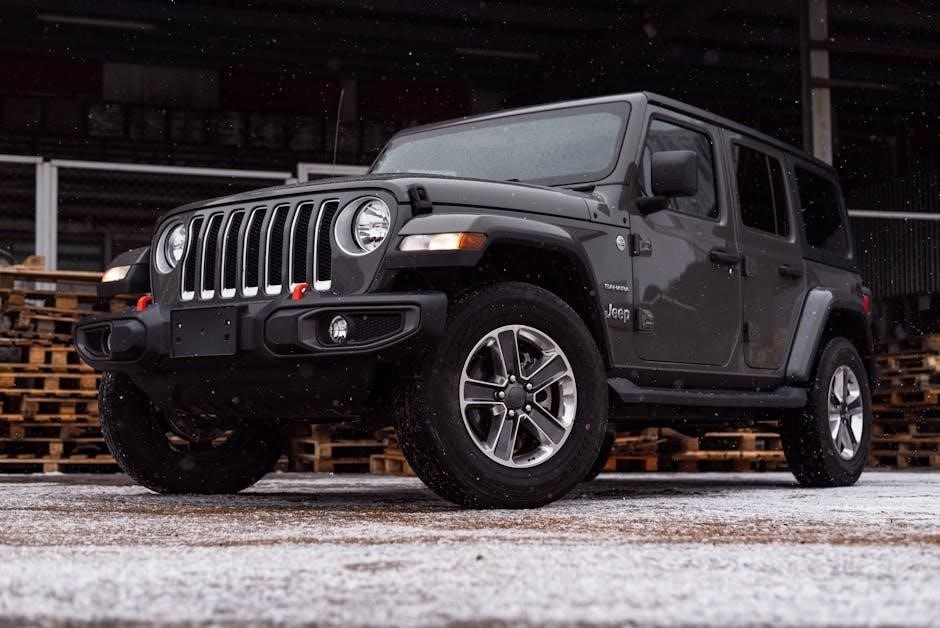Understanding Wheel Offset Basics
Wheel offset is the distance from the wheel’s mounting hub to its centerline, measured in millimeters. It determines how the wheel sits inside the fender, impacting both aesthetics and handling. Positive, negative, or zero offset options exist, each affecting the vehicle’s stance and stability. Proper offset ensures correct tire fitment and alignment, especially for modified Jeep Wranglers with lift kits or larger tires.
What is Wheel Offset?
Wheel offset is the measured distance between the wheel’s mounting hub and its centerline, expressed in millimeters. It determines how the wheel sits within the fender, affecting both aesthetics and vehicle handling; A positive offset means the hub is closer to the road side, while a negative offset places it toward the brake side. Zero offset centers the hub on the wheel. For Jeep Wranglers, proper offset ensures tires fit without rubbing and maintains stability. Incorrect offset can lead to poor alignment, reduced traction, or clearance issues, especially with lifted vehicles or larger tires. Understanding offset is crucial for maintaining performance and safety.
Wheel Offset and Backspacing
Wheel offset and backspacing measure wheel positioning. Offset is the hub-to-centerline distance, while backspacing is the hub-to-inner-rim distance. Both ensure proper tire fitment and clearance for Jeep Wranglers.
What is Backspacing?
Backspacing, measured in inches, is the distance from the wheel’s hub to the inner edge of the rim. It ensures tires fit within the fender without rubbing, crucial for Jeep Wranglers with lift kits or oversized tires. Proper backspacing prevents uneven tire wear and improves handling. It complements wheel offset, ensuring a balanced stance and maximizing off-road performance.
How Offset and Backspacing Relate
Wheel offset and backspacing are closely linked, as both determine how tires fit within the fender wells of a Jeep Wrangler. Offset measures the hub-to-centerline distance, while backspacing measures hub-to-inner-rim distance. Together, they ensure proper tire positioning, preventing rubbing and maintaining stability. A higher offset with reduced backspacing pushes the tire outward, while a lower offset with increased backspacing pulls it inward. For modified Wranglers, especially those with lift kits or wider tires, balancing these measurements is critical to achieve optimal fitment and performance. Proper alignment ensures better handling, reduced wear, and enhanced off-road capability.
Bolt Pattern and Wheel Diameter
Bolt pattern and wheel diameter are critical for compatibility. Jeep Wranglers typically use 5×5″ or 5×4.5″ bolt patterns, with diameters from 15″ to 20″. Matching ensures proper fitment.
Bolt Pattern Considerations
For Jeep Wranglers, selecting the correct bolt pattern is essential for proper wheel fitment. The bolt pattern refers to the number of bolts and the distance between them. Common patterns include 5×4.5″ and 5×5″. Jeep Wranglers typically use a 5×5″ bolt pattern, but some models may have a 5×4.5″ pattern. It’s crucial to verify your vehicle’s specifications before purchasing wheels. Mismatched bolt patterns can lead to improper fitment, affecting safety and performance. Always double-check your Jeep’s specifications to ensure compatibility with aftermarket wheels. Using a wheel with the wrong bolt pattern can cause damage to the vehicle or result in a unsafe driving condition. Proper alignment ensures optimal performance and safety on the road. Additionally, using the correct bolt pattern maintains the structural integrity of the wheel and hub assembly. Never compromise on bolt pattern accuracy for aftermarket wheels. Always consult a professional if unsure about compatibility or fitment. Proper installation ensures a secure and safe driving experience. Wheel bolt pattern accuracy is non-negotiable for maintaining vehicle safety and reliability. Always adhere to manufacturer guidelines when selecting wheels for your Jeep Wrangler. Misaligned bolt patterns can cause uneven stress on the wheel and hub, leading to potential failure. Ensuring the correct bolt pattern is the first step in achieving a proper wheel fitment. Verify your vehicle’s specifications to make an informed decision. Accurate bolt pattern matching ensures a safe and reliable driving experience. Never overlook this critical aspect of wheel selection. Proper fitment guarantees optimal performance and longevity of your Jeep’s wheels and suspension system. Always prioritize accuracy when selecting wheels for your vehicle. Bolt pattern compatibility is fundamental for maintaining safety and performance standards. Always refer to your Jeep’s specifications to ensure correct fitment and function. Misaligned bolt patterns can lead to costly repairs and compromised safety. Prioritize accuracy for a secure and reliable driving experience. Always verify bolt pattern compatibility before installing new wheels on your Jeep Wrangler. Proper fitment ensures safety, performance, and longevity of your vehicle’s components. Never compromise on bolt pattern accuracy for the sake of aesthetics or cost. Safety and reliability should always be the top priority when selecting wheels for your Jeep. Accurate bolt pattern matching ensures a secure and reliable connection between the wheel and hub. Always double-check your vehicle’s specifications to avoid potential issues. Proper bolt pattern fitment is essential for maintaining the structural integrity of your Jeep’s wheel and suspension system. Never overlook this critical aspect of wheel selection. Always ensure compatibility to guarantee a safe and enjoyable driving experience. Bolt pattern accuracy is non-negotiable for optimal performance and safety. Always adhere to manufacturer guidelines and specifications when selecting wheels for your Jeep Wrangler. Proper fitment ensures a secure connection and optimal performance. Never compromise on bolt pattern accuracy to maintain your vehicle’s safety and reliability. Always verify compatibility before making a purchase. Accurate bolt pattern matching is essential for proper wheel fitment and function. Always prioritize accuracy for a safe and reliable driving experience. Proper bolt pattern fitment guarantees optimal performance and longevity of your Jeep’s components. Never overlook this critical aspect of wheel selection. Always ensure compatibility to avoid potential issues and maintain safety. Bolt pattern accuracy is fundamental for a secure and reliable connection between the wheel and hub; Always double-check your vehicle’s specifications to ensure correct fitment. Proper bolt pattern matching ensures a safe and enjoyable driving experience. Never compromise on accuracy for the sake of aesthetics or cost. Safety and reliability should always be your top priority when selecting wheels for your Jeep Wrangler. Accurate bolt pattern fitment is essential for maintaining the structural integrity of your vehicle’s wheel and suspension system. Always refer to your Jeep’s specifications to make an informed decision. Proper fitment ensures optimal performance and longevity of your vehicle’s components. Never overlook this critical aspect of wheel selection. Always prioritize accuracy for a safe and reliable driving experience. Bolt pattern compatibility is non-negotiable for maintaining safety and performance standards. Always adhere to manufacturer guidelines when selecting wheels for your Jeep. Proper fitment guarantees a secure connection and optimal performance. Never compromise on bolt pattern accuracy to maintain your vehicle’s safety and reliability. Always verify compatibility before installing new wheels. Accurate bolt pattern matching ensures a secure and reliable driving experience. Proper fitment is essential for maintaining the structural integrity of your Jeep’s wheel and suspension system. Always double-check your vehicle’s specifications to avoid potential issues. Bolt pattern accuracy ensures a safe and enjoyable driving experience. Never overlook this critical aspect of wheel selection. Always ensure compatibility to maintain safety and performance. Accurate bolt pattern matching is fundamental for proper wheel fitment and function. Always prioritize accuracy for a safe and reliable driving experience. Proper bolt pattern fitment guarantees optimal performance and longevity of your Jeep’s components. Never compromise on accuracy for the sake of aesthetics or cost. Safety and reliability should always be your top priority when selecting wheels for your Jeep Wrangler. Accurate bolt pattern fitment is essential for maintaining the structural integrity of your vehicle’s wheel and suspension system. Always refer to your Jeep’s specifications to make an informed decision. Proper fitment ensures optimal performance and longevity of your vehicle’s components. Never overlook this critical aspect of wheel selection. Always prioritize accuracy for a safe and reliable driving experience. Bolt pattern compatibility is non-negotiable for maintaining safety and performance standards. Always adhere to manufacturer guidelines when selecting wheels for your Jeep. Proper fitment guarantees a secure connection and optimal performance. Never compromise on bolt pattern accuracy to maintain your vehicle’s safety and reliability. Always verify compatibility before making a purchase. Accurate bolt pattern matching ensures a secure and reliable connection between the wheel and hub. Always double-check your vehicle’s specifications to avoid potential issues. Proper bolt pattern fitment is essential for maintaining the structural integrity of your Jeep’s wheel and suspension system. Never overlook this critical aspect of wheel selection. Always ensure compatibility to avoid potential issues and maintain safety. Bolt pattern accuracy is fundamental for a secure and reliable connection between the wheel and hub. Always double-check your vehicle’s specifications to ensure correct fitment. Proper bolt pattern matching ensures a safe and enjoyable driving experience. Never compromise on accuracy for the sake of aesthetics or cost. Safety and reliability should always be your top priority when selecting wheels for your Jeep Wrangler. Accurate bolt pattern fitment is essential for maintaining the structural integrity of your vehicle’s wheel and suspension system. Always refer to your Jeep’s specifications to make an informed decision. Proper fitment ensures optimal performance and longevity of your vehicle’s components. Never overlook this critical aspect of wheel selection. Always prioritize accuracy for a safe and reliable driving experience. Bolt pattern compatibility is non-negotiable for maintaining safety and performance standards. Always adhere to manufacturer guidelines when selecting wheels for your Jeep. Proper fitment guarantees a secure connection and optimal performance. Never compromise on bolt pattern accuracy to maintain your vehicle’s safety and reliability. Always verify compatibility before installing new wheels. Accurate bolt pattern matching ensures a secure and reliable driving experience. Proper fitment is essential for maintaining the structural integrity of your Jeep’s wheel and suspension system. Always double-check your vehicle’s specifications to avoid potential issues. Bolt pattern accuracy ensures a safe and enjoyable driving experience. Never overlook this critical aspect of wheel selection. Always ensure compatibility to maintain safety and performance. Accurate bolt pattern matching is fundamental for proper wheel fitment and function. Always prioritize accuracy for a safe and reliable driving experience. Proper bolt pattern fitment guarantees optimal performance and longevity of your Jeep’s components. Never compromise on accuracy for the sake of aesthetics or cost. Safety and reliability should always be your top priority when selecting wheels for your Jeep Wrangler. Accurate bolt pattern fitment is essential for maintaining the structural integrity of your vehicle’s wheel and suspension system. Always refer to your Jeep’s specifications to make an informed decision. Proper fitment ensures optimal performance and longevity of your vehicle’s components. Never overlook this critical aspect of wheel selection. Always prioritize accuracy for a safe and reliable driving experience. Bolt pattern compatibility is non-negotiable for maintaining safety and performance standards. Always adhere to manufacturer guidelines when selecting wheels for your Jeep. Proper fitment guarantees a secure connection and optimal performance. Never compromise on bolt pattern accuracy to maintain your vehicle’s safety and reliability. Always verify compatibility before making a purchase. Accurate bolt pattern matching ensures a secure and reliable connection between the wheel and hub. Always double-check your vehicle’s specifications to avoid potential issues. Proper bolt pattern fitment is essential for maintaining the structural integrity of your Jeep’s wheel and suspension system. Never overlook this critical aspect of wheel selection. Always ensure compatibility to avoid potential issues and maintain safety. Bolt pattern accuracy is fundamental for a secure and reliable connection between the wheel and hub. Always double-check your vehicle’s specifications to ensure correct fitment. Proper bolt pattern matching ensures a safe and enjoyable driving experience. Never compromise on accuracy for the sake of aesthetics or cost. Safety and reliability should always be your top priority when selecting wheels for your Jeep Wrangler. Accurate bolt pattern fitment is essential for maintaining the structural integrity of your vehicle’s wheel and suspension system. Always refer to your Jeep’s specifications to make an informed decision. Proper fitment ensures optimal performance and longevity of your vehicle’s components. Never overlook this critical aspect of wheel selection. Always prioritize accuracy for a safe and reliable driving experience. Bolt pattern compatibility is non-negotiable for maintaining safety and performance standards. Always adhere to manufacturer guidelines when selecting wheels for your Jeep. Proper fitment guarantees a secure connection and optimal performance. Never compromise on bolt pattern accuracy to maintain your vehicle’s safety and reliability. Always verify compatibility before installing new wheels. Accurate bolt pattern matching ensures a secure and reliable driving experience. Proper fitment is essential for maintaining the structural integrity of your Jeep’s wheel and suspension system. Always double-check your vehicle’s specifications to avoid potential issues. Bolt pattern accuracy ensures a safe and enjoyable driving experience. Never overlook this critical aspect of wheel selection. Always ensure compatibility to maintain safety and performance. Accurate bolt pattern matching is fundamental for proper wheel fitment and function. Always prioritize accuracy for a
Wheel Diameter and Tire Size
Wheel diameter and tire size are closely related, as the wheel must accommodate the tire properly. For Jeep Wranglers, common wheel diameters range from 15 to 20 inches, depending on the model and intended use. The tire size must match the wheel diameter to ensure proper fitment and performance. Larger wheels with smaller tires can affect ground clearance and ride quality, while smaller wheels with larger tires may rub against the fenders. When upgrading, it’s crucial to maintain compatibility between the wheel diameter and tire size for optimal traction and handling. Always consult a fitment guide or professional to ensure the correct combination for your Jeep Wrangler.
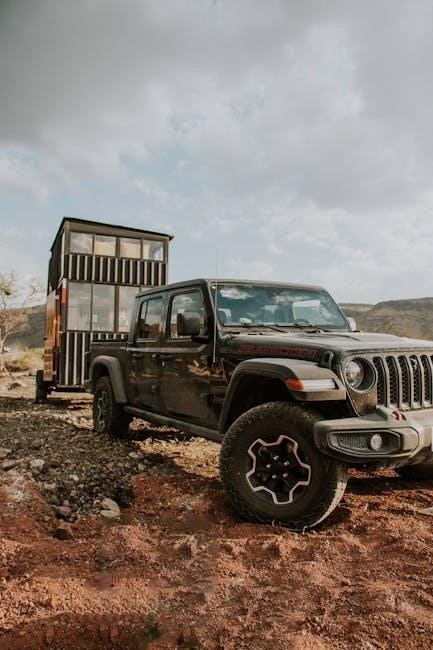
Hub-Centric vs. Lug-Centric Wheels
Hub-centric wheels are centered on the vehicle’s hub, ensuring precise alignment and reducing vibrations for a smoother ride. Lug-centric wheels rely on lug nuts for centering, offering simplicity but less precision. Choosing the right type depends on your Jeep Wrangler’s needs, balancing performance, compatibility, and budget.
Hub-Centric Wheels
Hub-centric wheels are designed to fit precisely on the vehicle’s hub, ensuring proper alignment and reducing vibrations. This design centers the wheel on the hub bore, providing a smoother ride and better handling. For Jeep Wranglers, hub-centric wheels are ideal as they maintain stability, especially during off-road adventures. The wheels are engineered to match the hub’s specifications, eliminating the need for additional spacers. This results in a more secure fitment and even stress distribution across the wheel and suspension. Hub-centric wheels are preferred for their durability and performance, making them a popular choice for enthusiasts seeking reliability and optimal vehicle behavior.
Lug-Centric Wheels
Lug-centric wheels rely on the lug nuts to center them on the hub, rather than the hub itself. This design is common in aftermarket wheels and offers more flexibility in fitment. However, improper installation or alignment can lead to vibrations or uneven stress on the suspension. Lug-centric wheels often require spacers or adapters to achieve proper fitment, especially on Jeep Wranglers. They provide versatility for customization but demand precise installation to ensure safety and performance. While they may not offer the same stability as hub-centric wheels, they remain a popular choice for enthusiasts seeking unique styling or specific offset requirements.
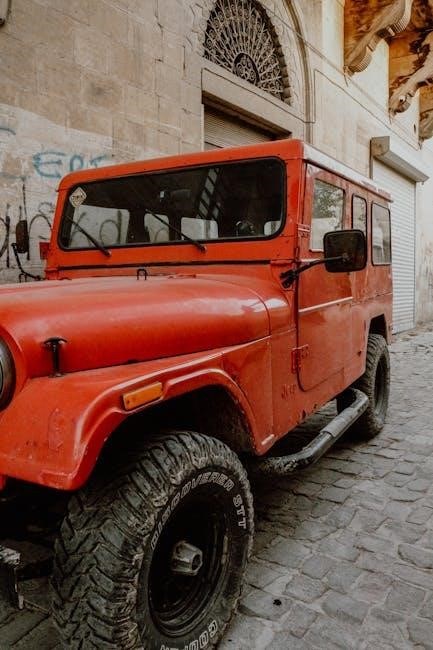
Lift Kits and Offset
Lift kits alter the Jeep Wrangler’s suspension height, affecting wheel offset. They can cause wheels to protrude or sit unevenly. Adjusting offset ensures proper fitment, preventing tire rub and enhancing aesthetics. Correct offset maintains handling and stability, crucial for both on-road performance and off-road adventures. Proper alignment and tire size compatibility are essential when modifying suspension height. This ensures safety and optimal vehicle functionality. Always consult specifications to achieve the right balance between lift and wheel offset for your Jeep Wrangler.
Impact of Lift Kits
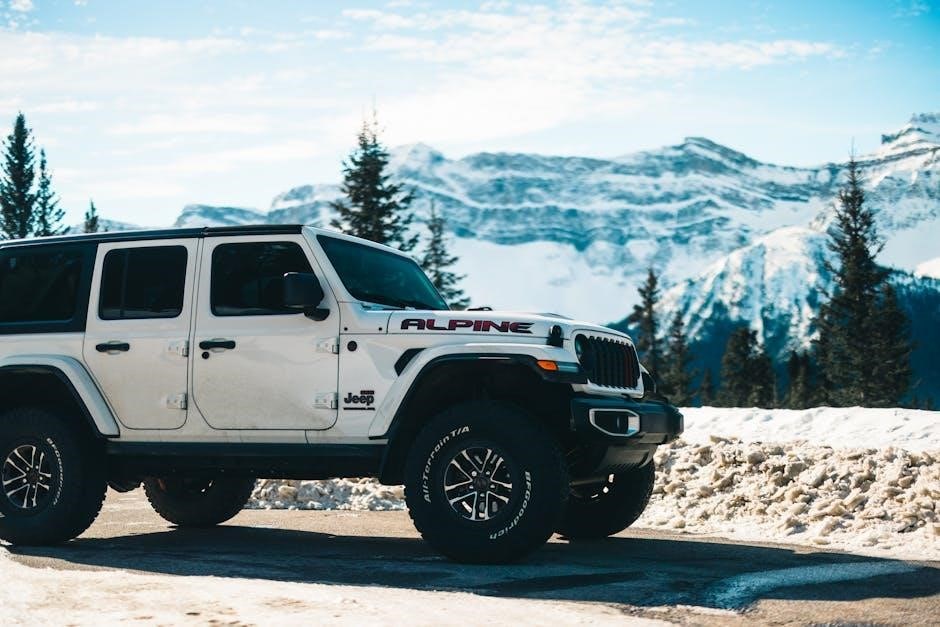
Lift kits raise the Jeep Wrangler’s suspension, altering its stance and affecting wheel offset. A lift increases the distance between the wheels and fenders, potentially causing wheels to protrude more. This can lead to improper tire fitment, rubbing against fenders or suspension components, and uneven tire wear. Lift kits also change the vehicle’s center of gravity, which impacts handling and stability. Proper wheel offset adjustment is crucial to maintain optimal performance and safety. Incorrect offset can result in reduced traction, poor alignment, and compromised aesthetics. Always ensure wheels are re-aligned and offset is recalibrated after installing a lift kit. Consulting with a specialist is recommended to achieve the best results for your Jeep Wrangler’s setup.
Calculating Offset for Lifts
Calculating the correct wheel offset after installing a lift kit on a Jeep Wrangler requires precise measurements to ensure proper fitment and performance. Start by measuring the lift height, then determine how much the wheel needs to be pulled inward or outward. A general rule of thumb is to decrease the offset by 1mm for every 1″ of lift. For example, a 2″ lift would require reducing the offset by 2mm. Use a formula like: new offset = current offset ⸺ (lift height * 2). This ensures the tires clear the fenders and suspension components. Always double-check measurements and consult a specialist for accurate results tailored to your Jeep’s modifications.

Tire Size and Offset
Tire size and offset are closely related. Larger tires may require specific offsets to ensure proper fitment. Use a calculator to balance both for optimal performance and appearance.
Choosing the Right Tire Size
Choosing the right tire size for your Jeep Wrangler involves considering several factors, including the vehicle’s lift, wheel offset, and intended use. Larger tires provide better ground clearance and traction, especially for off-road adventures, but they may require adjustments to wheel offset to ensure proper fitment. It’s essential to use a wheel fitment calculator to determine the optimal tire size and offset combination for your specific Jeep model. Additionally, consider the bolt pattern to ensure compatibility and decide between hub-centric or lug-centric wheels for stability and performance. Aesthetics and functionality should balance to maintain both the look and capability of your Jeep. Always consult reliable guides or experts to avoid fitment issues and ensure optimal performance on and off the road.
Wheel Width Considerations
Wheel width impacts both performance and aesthetics. Wider wheels enhance traction and stability, especially for off-road use, but require proper offset to avoid fender rubbing. Measure your setup or consult a fitment guide to ensure compatibility and optimal performance.
Wheel Width and Tire Fit
Wheel width directly impacts tire fitment and performance. Wider wheels allow for larger tires, enhancing traction and stability, especially off-road. However, improper width can lead to poor tire-to-fender clearance, causing rub or uneven wear. Always match tire size to wheel width, ensuring compatibility with the Jeep Wrangler’s axle and suspension setup. For lifted vehicles, wider wheels with appropriate offset can accommodate oversized tires without compromising fitment. Proper alignment and load rating are also critical to maintain safety and handling. Consult a fitment guide or professional to ensure your setup maximizes performance and avoids costly modifications. Correct wheel width and tire pairing ensures optimal functionality and aesthetics for your Jeep Wrangler.
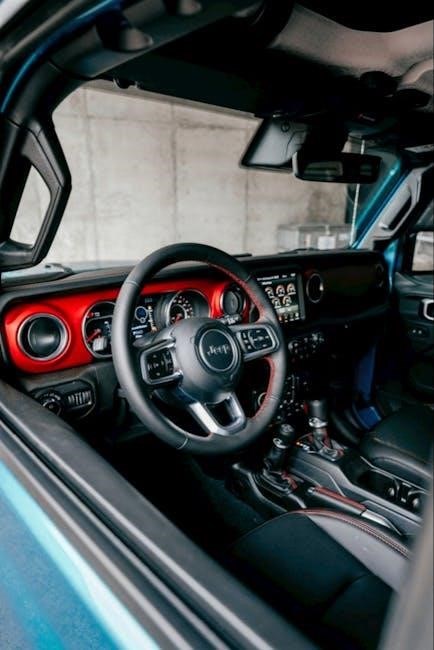
Aesthetics and Performance
Proper wheel offset balances aesthetics and performance, ensuring wheels fit flush within fenders for a sleek look while maintaining optimal handling and traction on various terrains.
Visual Appeal
Wheel offset significantly impacts the visual appeal of your Jeep Wrangler. A proper offset ensures wheels are flush with the fenders, creating a balanced and aggressive stance. This enhances the vehicle’s overall aesthetic, making it look more rugged and polished. For Jeep enthusiasts, achieving the perfect stance is crucial for both on-road presence and off-road functionality. Incorrect offset can make wheels appear too inset or protruding, detracting from the vehicle’s appearance. By selecting the right offset, owners can tailor their Jeep’s look to their personal style, whether it’s a sleek, modern design or a classic, adventurous vibe.
Handling and Traction
Wheel offset plays a critical role in maintaining optimal handling and traction for your Jeep Wrangler. Proper offset ensures even weight distribution across the tires, enhancing stability and control, especially during sharp turns or off-road adventures. A correct offset prevents uneven tire wear and improves braking performance, while incorrect offset can lead to reduced traction and compromised safety. For off-road enthusiasts, the right offset ensures maximum tire contact with the terrain, enhancing grip and maneuverability. Incorrect offset may cause vibrations or wobbling, particularly at higher speeds, affecting overall driving performance. Balancing aesthetics with functionality is key to maintaining your Jeep’s handling and traction capabilities.
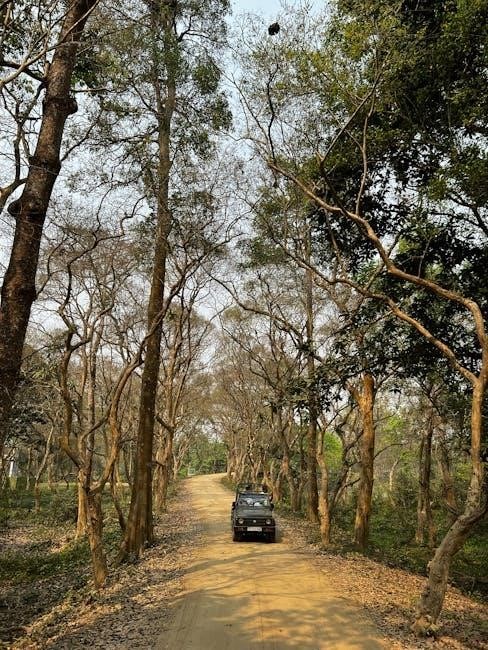
Availability and Recommendations
Wheel offset options for Jeep Wranglers are widely available, with manufacturers offering various sizes to suit different lift kits and tire setups. Always consult a fitment guide to ensure compatibility and optimal performance, as incorrect offset can compromise safety and handling. Recommendations vary based on desired aesthetics, tire size, and driving conditions. Popular brands provide durable, high-quality wheels tailored for Wranglers, ensuring both style and functionality. Proper selection enhances both on-road stability and off-road capability, making it crucial to choose wheels that align with your vehicle’s specifications and usage. Expert advice from specialists is recommended for precise fitment.
Market Availability
The Jeep Wrangler wheel offset market offers a wide range of options, catering to both stock and modified vehicles. Popular brands like Method Race Wheels, Fuel Off-Road, and KMC provide durable, stylish wheels with precise offsets. Online retailers such as Amazon, RockAuto, and 4WheelParts offer extensive selections, while local auto shops also carry specialized fitments. The availability of wheels in various finishes, bolt patterns, and diameters ensures compatibility with different Wrangler models and lift kits. Competitive pricing and frequent sales make upgrading wheels accessible. Additionally, custom wheel manufacturers provide bespoke solutions for unique setups. With so many options, enthusiasts can easily find wheels that match their Wrangler’s specifications and personal style, ensuring optimal performance and aesthetics.
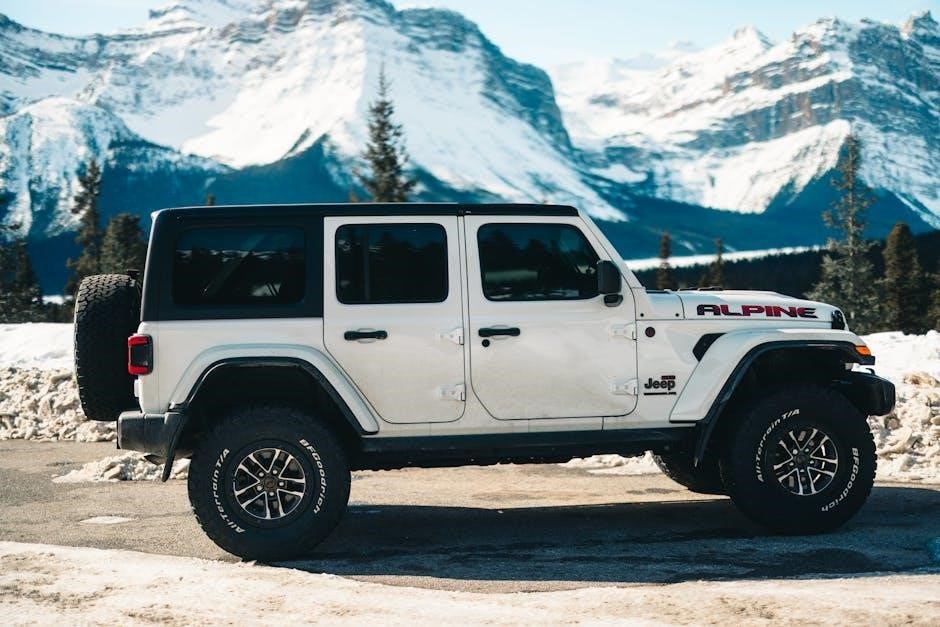
Step-by-Step Guide
- Measure your Jeep’s current wheel setup and vehicle specifications.
- Calculate desired offset based on lift kits and tire size.
- Select compatible wheels and verify fitment.
- Install and test for proper clearance and alignment.
Step 1: Understand Basics
Understanding wheel offset basics is crucial for modifying your Jeep Wrangler. Start by identifying your vehicle’s specifications, such as bolt pattern, hub size, and current wheel setup. Measure your Wrangler’s fender clearance to ensure the new wheels won’t rub. Research the differences between hub-centric and lug-centric wheels, as this affects balancing and installation. Familiarize yourself with terms like positive, negative, and zero offset to determine how the wheels will sit in the fender wells. Finally, note the impact of lift kits on the overall geometry and how they influence the optimal offset for your setup. This foundational knowledge ensures a smooth upgrade process.
Step 2: Measure and Consider
Measure your Jeep Wrangler’s current wheel setup, including backspacing and overall width. Use a tape measure to check fender clearance and ensure the new wheels won’t rub. Consider the impact of lift kits on suspension geometry and how they affect the desired offset. Compare your findings with the specifications of the wheels you’re interested in. Take note of the bolt pattern and hub size to ensure compatibility. Additionally, think about the tire size and how it interacts with the wheel’s offset for proper fitment. This step ensures that your chosen wheels not only look great but also function seamlessly with your Wrangler’s modifications.
Step 3: Choose Wheels
Select wheels that match your Jeep Wrangler’s bolt pattern, hub size, and desired offset. Consider the width to ensure proper tire fitment without rubbing. Check material options like aluminum or steel for durability and style. Think about the vehicle’s intended use—on-road, off-road, or both—and how it affects wheel choice. Compare brands and reviews to find reputable options. Ensure the wheels are compatible with your lift kit and suspension upgrades. Finally, verify load ratings to support the weight of your Wrangler, especially if you’ve added modifications like winches or larger tires. Choosing the right wheels enhances both performance and aesthetics, ensuring a perfect fit for your Jeep’s unique setup.
Step 4: Verify Fitment
Once you’ve selected your wheels, ensure they fit your Jeep Wrangler perfectly. Double-check measurements like backspacing, offset, and diameter to confirm compatibility. Test-fit the wheels on the vehicle before installing tires to avoid any clearance issues. Larger tires may require adjustments to prevent rubbing against fenders or suspension components. A test drive is essential to ensure proper handling and alignment. If unsure, consult a wheel fitment guide or seek professional advice to confirm compatibility. Proper fitment guarantees safety, optimal performance, and a seamless driving experience, whether on-road or off-road.
